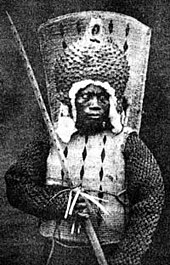Nauruan tribal war
The Nauruan Tribal War was a war between the twelve tribes on the Pacific island of Nauru and lasted from 1878 to October 3, 1888. The war claimed at least 500 lives, which at that time made up about a third of the Nauruan ethnic group ; the population fell from 1,400 (1843) to 900 inhabitants (1888).
causes
Since the discovery of the British crowned Naurus in 1798 by John Fearn, many ships avoided the island as it was a notorious base for pirates and pirates. Nevertheless, in the course of the 19th century the immigration of European emigrants, often outlaws, steadily increased. Especially the importation of alcohol and firearms disrupted traditional life. For millennia, the Nauru toddy only consumed toddy when it dripped from the cut coconut blossom ; Since the 1800s, the toddy has been fermented for several days, making it sour and drunk regularly.
outbreak

The tribal war had started during a wedding reception ; When an exchange about the etiquette turned into a heated discussion, one of the guests fired a shot with his pistol, which happened to kill a young chief . It was clear that the young chief's death must be avenged. In earlier times, such tribal feuds had their origins in similarly random accidents, only this time each family of each tribe had firearms; in addition, the Nauruans by the so-called intrigues were beach runners , released prisoners and abgeheuerter whalers from Europe , goaded. Several deadly shootings kept most of the Nauru participating in the feud. A kind of guerrilla war broke out; one accidentally shot at each other or sneaked into enemy houses during the night and shot at candles , matches and anything that moved. Women and children were slaughtered. Unlike previous conflicts, where peace was restored through traditional behavior, this did not resolve the dispute.
War reports
A squadron of the British Royal Navy anchored off Nauru on September 21, 1881, and the flagship approached the island to assess the situation. The acculturated sandpiper William Harris got on board the ship, which in the evening telegraphed to the rest of the squadron via semaphore that a civil war was raging, that an escaped convict was king and that everyone was always drunk. The actual king of the island, Auweyida , is said to have wanted a missionary ; he was obviously hungry.
Six years later, Auckland- based Brit Frederick J. Moss came to Nauru in the schooner Buster and went ashore while the ship was loading copra . He reported that the Nauru people were friendly and in good spirits, although most of the boys and all men were armed with rifles and carbines . The war was still going on, but they seemed to have had enough. From his conversations with the Nauruians, Moss noticed that no one wanted to continue fighting, but no one trusted the other to lay down their weapons . They wished that one would disarm them all at once. Moss also reported talking to Harris that two of his family members had already been shot and that he had repeatedly expressed his desire for a mission to restore peace to the island.
German annexation and end of the war
The tribal war neither increased copra production , nor could the interests of the German traders and merchants who founded coconut plantations and branches in Nauru be guaranteed. Therefore, the traders and the German officials suggested that Germany should take over sovereignty in Nauru. On April 16, 1888, Nauru came under the German protectorate of the Marshall Islands and declared an island-wide ban on alcohol consumption and weapons. On October 1, 1888, the gunboat SMS Eber (1) anchored off Nauru with 87 men on board. The armed sailors, accompanied by Harris, ran around the island and returned from the Gilbert Islands with the twelve tribal chiefs, the European settlers and the missionary who had just arrived . The seamen put the chiefs under arrest until the following morning when the annexation ceremony took place with the hoisting of the German flag. Germany stated that all weapons and ammunition had to be delivered within 24 hours ; Otherwise, the chiefs would have threatened imprisonment and subsequent execution . On the morning of October 3, 765 weapons with at least 1,000 rounds of ammunition were handed in. This ended the bloodiest tribal war in Nauruan history.
consequences
The annexation of Naurus by Germany prevented the potential self-extermination of the Nauru people through alcohol and weapons, but at the same time they lost control of their island and their fate for almost 80 years. In addition, King Auweyida was reinstated as head of the island. In 1914 Germany lost Nauru as a colony to Australia without a fight .
See also
literature
- Luc Folliet: Nauru. The devastated island. How capitalism destroyed the richest country on earth., Verlag Klaus Wagenbach, Berlin 2011, ISBN 978-3-8031-2654-2
- Hermann Mückler : The Marshall Islands and Nauru in German colonial times. South Sea islanders, traders and colonial officials in old photographs. Berlin 2016, ISBN 978-3-7329-0285-9
